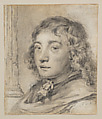Portrait of a Young Man (probably a self-portrait)
Cornelis Visscher Dutch
Not on view
This signed drawing by Haarlem draftsman and printmaker Cornelis Visscher (1629–1658) exhibits the virtuoso handling of black chalk for which the artist was praised in 1718 by famous Dutch biographer Arnold Houbraken. Over the course of his roughly decade-long career, cut short by his premature death in 1658, Visscher produced numerous portrait drawings and hundreds of prints. The crisp modeling of the face and rapid but precise rendering of the locks of hair in the present sheet are hallmarks of Visscher’s draftsmanship. The glinting eyes and parted lips imbue the drawing—almost certainly a self-portrait—with a particular liveliness.
The sitter’s features correspond closely to those in Visscher’s other known self-portraits: engravings of 1649 and 1651 and five drawings long held in public collections (two in the British Museum; two in the Rijksmuseum; one in the Musée Carnavalet); along with a possible drawn self-portrait in the Albertina).[1] That Visscher produced multiple self-portraits reflects a broader vogue for artists’ likenesses in the 17th-century Dutch Republic and, likely, his personal ambition as well. Rembrandt's example, and specifically his etched self-portrait of 1639 (MMA 29.107.25), may have offered a model for the younger artist in self-portrayal and promotion.
A copy of the present sheet attributed to Jonas Umbach is housed in the Museum Kunst Palast in Düsseldorf.
[1] See John Hawley, "The Drawings of Cornelis Visscher (1628/9-1658)," Ph.D. diss. University of Virginia, 2015.
This image cannot be enlarged, viewed at full screen, or downloaded.


